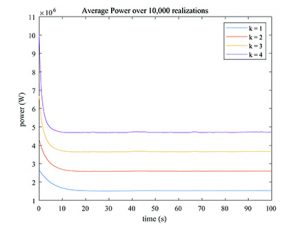Reliability Analysis of Novel Wind-Energy Conversion System
MS student Isaac Lawanson with advisor A. Domínguez-García
We analyze various power converter architectures for wind-energy conversion systems to determine the system’s reliability and availability (based on the inclusion of passive rectifiers). Using Chapman-Kolmogorov equations, we build the Markov reliability and availability models that show the various states of the architecture and the probability of state transitions. This can be for sensitivity analysis of the different components comprising the architectures.
We then determine the average power produced by an offshore wind turbine with novel converter architecture, an integrated generator rectifier system with bypass structure that isolates passive rectifiers from the main system when there is a component failure. This converter architecture, with higher availability compared to architectures with no bypass structure, has various states in its Markov availability model with varying long-term probabilities and distinct power production outputs. Reduced-order models created with single-perturbation analysis, for each state of the full wind-energy conversion system are generated and fed with 10,000 realizations of a Weibull distribution of typical offshore wind speeds to determine the output average power. This research is supported by ARPA-E.
